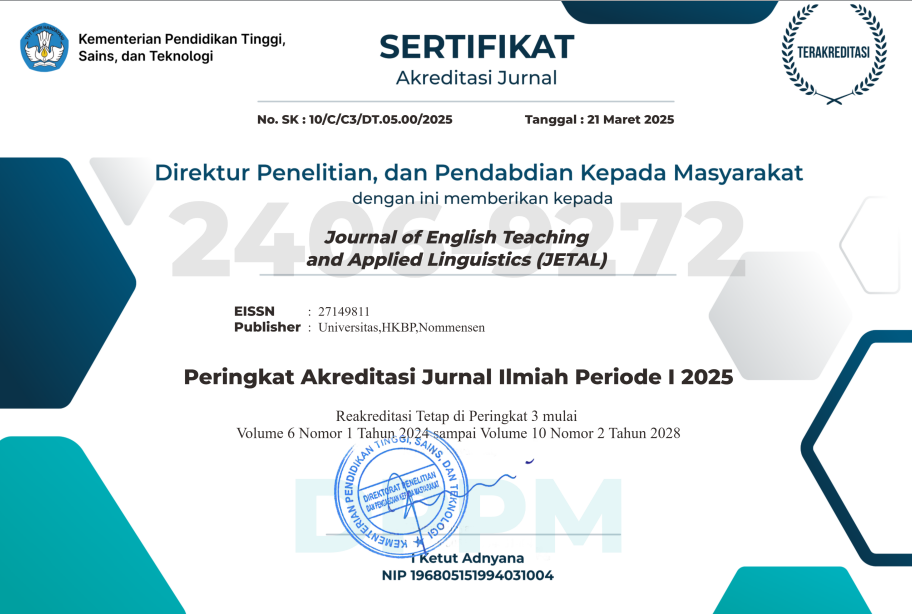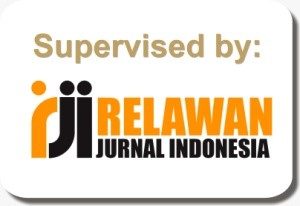THE ANALYSIS OF CODE SWITCHING AND CODE MIXING PHENOMENON IN ENGLISH FACEBOOK GROUP OF YOUTH COMMUNITY
Abstract
The phenomenon of code switching and code mixing has appeared in our daily life as an event or a trend around us. Facebook as a social media has become of code switching and code mixing phenomenon. This study aimed to analyze and to compare the kind of code switching and code mixing in Facebook group of English Youth Community. The analyzing process of code switching and code mixing in English Youth Community was taken from some comments of the members in English Youth Community where the researcher took screenshot of the members’ comments on Facebook group then analyzed the code switching and code mixing phenomenon in the comments of the members. The resarch subjects of this study are the members of English Youth Community on Facebook group. The method of this study was descriptive qualitative since the researcher intended to obtain the conversations among the members of English Youth Community on Facebook. The result of this study showed that intra essential code switching is the most widely used in some comments in English Youth Community than intra essential code switching and extra essential code switching. Code switching and code mixing phenomenon are done consciously by the members because of the change situation or the change of the topic in the English Youth Community group.
References
Chaer, A & Agustina L. (2010). Sosiolinguistik Perkenalan Awal. Rineka Cipta: Jakarta.
Das, A & Gamback, B. (2013). Code mixing in social media text: The last language identification frontier?. TAL, 54. 41-64.
Halim, S. N & Maros, M. (2014). The Functions of Code-switching in Facebook Interactions. Procedia - Social and Behavioral Sciences, 118, 126 – 133.
Kebeya, H. (2013). Inter- and Intra-Sentential Switching: Are they really Comparable?. International Journal of Humanities and Social Science, 3 (5), 225-233.
Koban, D (2012). Intra-sentential and inter-sentential code-switching in Turkish-English bilinguals in New York City, U.S. Procedia - Social and Behavioral Sciences, 70, 1174 – 1179.
Mesthrie, R., Swann, J., Deumert, A., & Leap, W.L. (2000). Introducing Sociolinguistics. Edinburgh: Edinburgh University Press.
Rodliya, S. R. (2016). Using a facebook closed group to improve EFL students’ writing. TEFLIN Journal, 27 (1), 82-100.
Soon, C., Mahiznhan, A., Juhari, S., Liang, J.S., & Amalina, A. (2014). Study on Chinese, Malay and Tamil Blogospheres in Singapore. Institute of Policy Studies, 1-116.
Suthiwartnarueput, S & Wasanasomsithi, P. (2012). Effects of Using Facebook as a Medium for Discussions of English Grammar and Writing of Low-Intermediate EFL Students. Electronic Journal of Foreign Language Teaching, 9 (2), 194-214.
Voss, C., Tratz, S., Laoudi, J., & Briesch, D. (2013). Finding Romanized Arabic Dialect in Code-Mixed Tweets. Army Research Laboratory. 2249-2253.
Vyas, Y., Gella, S., Sharma, J., Bali, K., & Choudhury, M. (2014). POS Tagging of English-Hindi Code-Mixed Social Media Content. Proceedings of the 2014 Conference on Empirical Methods in Natural Language Processing (EMNLP), 974-979.
Authors retain copyright and grant the journal right of first publication with the work simultaneously licensed under a Creative Commons Attribution-ShareAlike 4.0 International License (CC BY-SA 4.0) that allows others to share the work with an acknowledgment of the work's authorship and initial publication in this journal.
Authors are able to enter into separate, additional contractual arrangements for the non-exclusive distribution of the journal's published version of the work (e.g., post it to an institutional repository or publish it in a book), with an acknowledgment of its initial publication in this journal.
Authors are permitted and encouraged to post their work online (e.g., in institutional repositories or on their website) prior to and during the submission process, as it can lead to productive exchanges, as well as earlier and greater citation of published work (See The Effect of Open Access).






